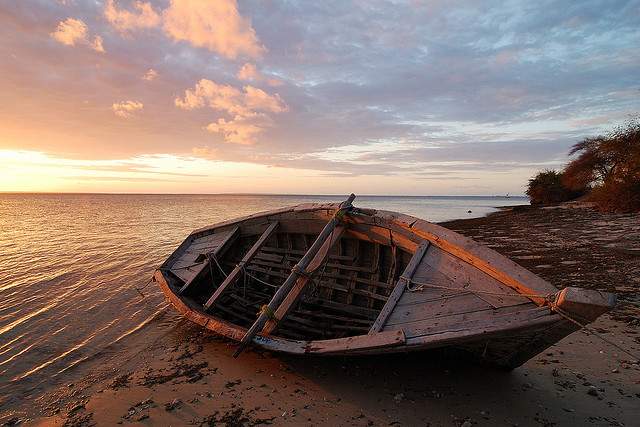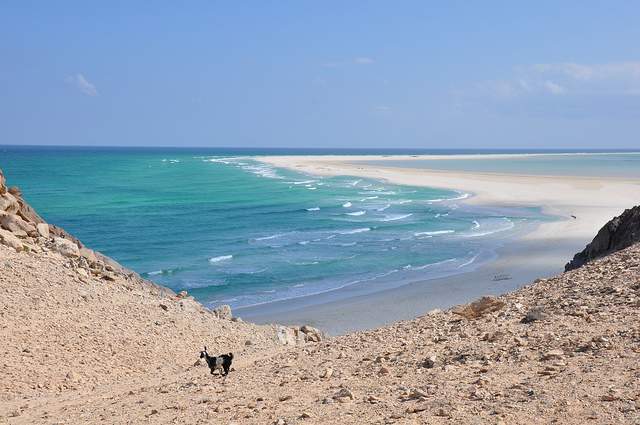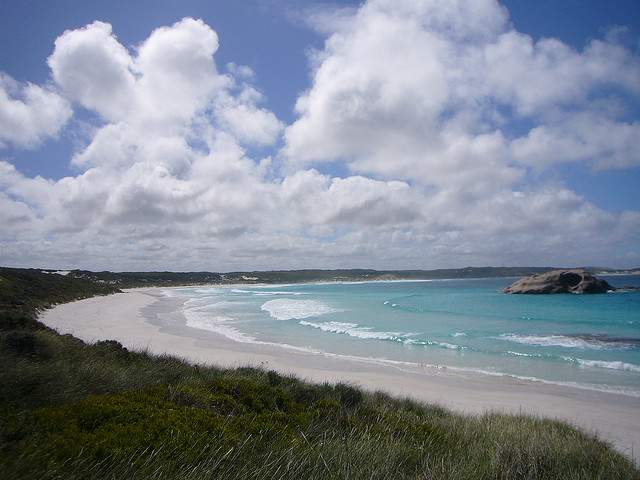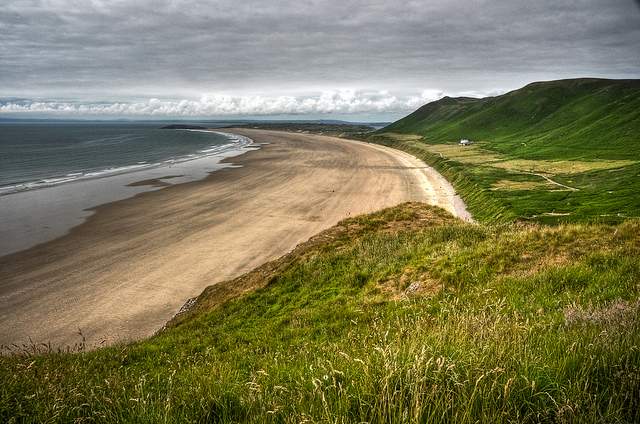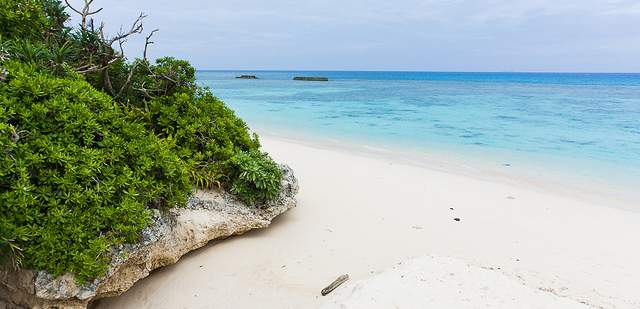In most travel guidebooks, websites and convivial hostel conversations, the beach has assumed the role of relaxant, inner calm-creator, and general geographic location that seems manufactured for letting off some steam. It’s no surprise then on an extended travel trip when fatigue, homesickness or perhaps simple curiosity finds you searching for a quiet pocket of Sweet’n Low sand to plug in your bikini bottoms and recharge those RTW motivations.
Unfortunately, many of the best-kept-secrets and ultimate island getaways circulating around the travel world these days are nothing more than overcrowded, de-virginized money pits where the tourists outnumber the locals infinity to one and the number of umbrellas on the beach is only surpassed by the number of people offering to braid your hair with yellow, red and green beads. But for the most part, the 10 beaches we’ve chosen for this list are far enough off the beaten path that a mention in this article or previous shout-outs in other travel publications aren’t likely to send the hordes sailing a direct route towards commercial destruction.
But that doesn’t mean you shouldn’t trace the route yourself, as here are 10 unspoiled and off-the-beaten-path beaches that are sure to be a highlight of your next RTW journey.
Radhanagar Beach, Havelock Island, India
[indieometeroverimage location_id=1157]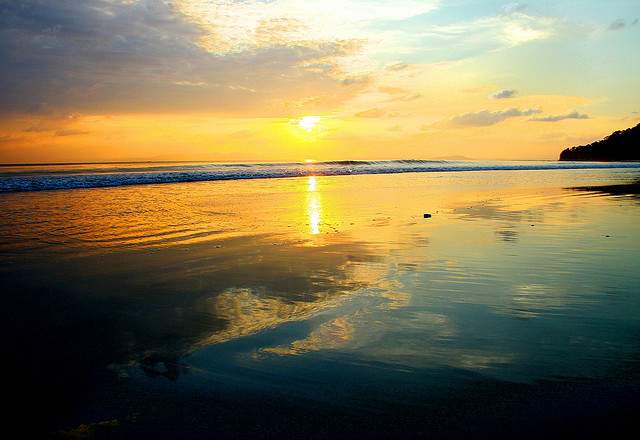
Radhanagar Beach has made some noticeable waves in the travel world despite its calm, dreamy waters that gently undulate like sleeping tidal lungs. In 2004, it was voted Best Beach in Asia by TIME Magazine, and thus although officially and perhaps inconspicuously dubbed Beach #7, Radhanagar is no longer hiding behind an underwhelming name and the thick forest that shelters its semi-precious shores. Yet surprisingly, quiet pockets of powder to lay down a blanket and bask in semi-sweet seclusion are as common as gelato parlors in Rome.
Radhanagar is on the western coast of Havelock Island, part of the Andaman and Nicobar Islands floating between India and Thailand, and getting there can be a bit of a hassle, or conversely, too expensive; a double edged concoction of mitigating factors that might lure any willing RTW traveler as what it ultimately means is “crowd control.” Flights leave from several Indian cities to Port Blair, the capital and gateway to the islands, or go directly to Havelock from Chennai or Kolkata. But for the adventure seeking and budget conscious, ships generally sail two-three times a month from Chennai, Kolkata and Vishakapatnam to Port Blair, and once there it’s another 2-4 hour ferry ride to Havelock. You can take a bus, auto-rickshaw or share-truck from the port to the beach.
And at that point Randhanagar is little more than beach huts and coconuts seasoned with a few local food shacks for flavor.
>> Find more beaches in India or book an relaxing trip to southern India
Taroa Beach, Punta Gallinas, Colombia
[indieometeroverimage location_id=1055]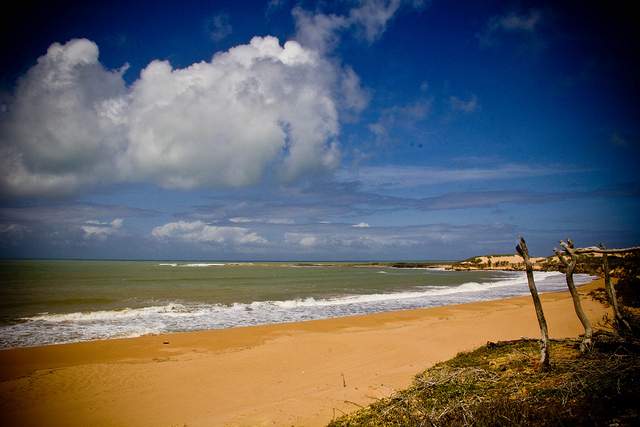
At the northernmost point in mainland South America ( in the La Guajira region of northern Colombia), copper dunes bow beneath a Crayola sky and carotene flamingoes perch in shallow teal pools along the Caribbean coast, providing the artist’s palette backdrop for a beach that convinces you the Big-Bang did something right. 60-meter high sand dunes collapse onto Taroa Beach and shelter it outside Punta Gallinas, Colombia, an obscure windswept Wayuu outpost with little infrastructure for tourists, creating a secluded earth-tone shoreline where your only other company is likely to be a few scrub bushes and a wild goat.
Most travelers go no further than the larger, almost as beautiful, and far more tourist-friendly Cabo de la Vela. But there you can arrange a 4-hour shared 4×4 jeep or lancha boat ride to Gallinas. The town, population 60, is a few outcroppings of houses and several lean-tos constructed by the native Wayuu people where travelers can claim a hammock. You can rent a guide or your own vehicle and head through the desert to Taroa, then spend the day lounging in your own private postcard before heading back to the hammock for some lobster, coconut rice and plantains.
>> Learn more about visiting Colombia or discover other beaches in Latin America
Ibo Island, Quirimbas Archipelago, Mozambique
Ibo Island was once Mozambique’s capital and a bustling African layover port that absorbed Swahili, Arab and Portuguese cultures creating a smorgasbord charm that presently remains in ancient forts, centuries old Hindu temples and the friendliness of the local people who wear white make-up to protect their faces from the sun. Today though, Ibo is a run-down, dusty enclave with three very nice accommodations but only enough rooms for one hotel amongst them. Add to that the often unreliable travel route to the island and most tourists find themselves opting for a different destination in the Querimba Archipelago.
But Ibo has three gorgeous beaches and sits on the third largest mangrove forest on earth, providing world-class sunbathing, snorkeling and kayak exploration. The Ibo Island Lodge even has a private sandbar beach, an isolated spit of sand between Ibo and Matemo Island that appears only during low tide providing the ultimate in unique, secluded beach experiences. If you’re looking to bypass the Lodge and two guesthouses on the island, Ibo also offers home stays for only $10 a night; outside of these tourist options there are only a few local joints where you can sample the indigenous cuisine and cross forks with the natives.
Getting to Ibo might be the greatest adventure, that is if you opt out of the short and pricey $300 return flight. From Pemba, a port city on the Mozambique mainland, you must take a bus or rent a 4×4 and guide for the rough and bumpy overland route to Tadanhangue. From there you can take a dhow boat over to Ibo which on a good day takes 1-2 hours. Unfortunately, winds, waters and tides play a large role in determining a ‘good day.’ If the tide becomes too low, the wind too strong, or the sea too choppy, which happens often and potentially without notice, your one hour leisurely boat ride could become a dingy overnight experience on a neighboring island. But of course, that’s all part of the fun.
>> Find flights to Mozambique or check out our Mozambique travel guide
Detwah Lagoon, Socotra Island, Yemen
On the western coast of Socotra Island, the white sands slope lethargically into the Indian Ocean creating a beach that demands a drastic redefinition of Paradise. Detwah Lagoon has no palm trees or hammocks, no coconuts with umbrella straws or steel drums resonating to the beat of easy living. There’s only barren desert and turquoise tides and a solitude scenery that looks like an expensive necklace. Detwah is the type of irresistible place that is both eerie and beckoning, an expanse of uninhibited vibrant beach that whispers over-exposed photo-op – and most of the time it will be exclusively yours.
Socotra is an isolated island belonging to the Republic of Yemen, 380 kilometers south of the Arabian Peninsula, so most tourists never get there. It’s so isolated in fact that a third of its plant species are endemic, which includes the odd umbrella shaped dragon’s blood tree which oozes crimson sap and contributes to the island’s otherworldly ambience. Socotra has little in the way of boat anchorage and in recent years sails from the mainland have been susceptible to pirate attacks, though that option is still available. You can also fly on Yemania Airlines from Sana’a on Fridays and from Aden on Mondays.
You will be deposited at Hadibo, the largest village on the island. Public min-vans ply the route regularly from there to Qalansiya which lies right before the hill overlooking Detwah. Your only option will be a campsite near the lagoon which rents tents, mattresses and blankets and offers fish, rice, bread, cheese, jam, drinking water and one of the most spectacular beaches in the world.
>> Yemen is listed on the US State Department Travel Warnings List due to terrorist activities and social unrest. If you do decide to book a flight to Yemen for this beach, just stay abreast of the situation.
Twilight Bay, Esperance, Australia
Esperance, also called the Bay of Isles, was voted Western Australia’s best town and the #2 town in the country. Cruising along its western edge is the aptly named Great Ocean Drive, which takes in over 11 gorgeous beaches in 11 miles, the best and most beautiful of these being Twighlight Bay. At Twighlight, sheer 70-meter granite cliffs dive into the cerulean waters and melted white chocolate sands, and weathered granite boulders gracefully breach the sea like prehistoric whales. Not surprisingly, the best time to visit is early evening during a full moon, when the last rays of the setting sun cast a pastel pall on the lunar Christmas ornament dangling at the tip of a waxing night.
Esperance is a 700 km day’s drive from Perth which keeps the majority of tourists away. And even many of those who do stop don’t stay long as the town is merely their last notable jaunt before a foray into Southern Australia. So during the summer there’s likely to be only a few sun seekers and in the off-season you’ll be sunning solo. The cove is a ten-minute drive from Esperance, located within the Nuystland Nature Reserve. Access is only by 4WD vehicles which must be rented, or alternatively you could walk the distance to the beach.
If you’re not road-tripping around Australia in a rented car or supped-up camper van, TransWA operates bus services which link Esperance to Perth, Albany, Norseman, Kalgoorlie and other towns in Western Australia. Skywest also offers an 80-minute daily service between Perth and Esperance.
>> Find flights to Perth or learn more about beaches in Australia
Puerto Patriada, Lago Epuyen, Argentina
Lago Epuyen is cradled deep within the Andes in the wunderkind region of off-the-beaten-path travel, Patagonia. It’s a tranquil lake knighted by a crown of snow-capped peaks and miles of sandy beaches perfect for secluded inner reflection… or just launching a kayak. In 1922, Martin Sheffield, a wander-lusting pioneer of sorts claimed he saw the Argentinean plesiosaur in Lago Epuyen and the lake made an impressive cameo in Bruce Chatwin’s In Patagonia as he went in search of Sheffield’s elusive monster. Today you’re likely to glimpse a more calm-inducing version of the local fauna as birds of prey silently etch geometry in the sky and the occasional horse saunters along the beach.
From the town of El Hoyo, where you’ll find many guesthouses, you take a 13 km gravel road past virgin Patagonian forest, apple and pear orchards, and horse pastures to Puerto Patriada on the northwest end of the lake. The port has camping and Argentinean barbecue facilities. If the few tourists and families who may also be visiting Lago Epuyen at Puerto Patriada cramp your maverick style, there are ample hiking opportunities around the lake to find yourself a quieter beach. An alternative option is to stay in El Bolson, a major travel hub of the region, or one of the other small towns near the lake and check out their corresponding ports and beaches.
>> Find a hostel in El Bolson or book a Patagonia adventure trip
Rhossili Beach, Gower Peninsula, Wales
The fact that Rhossili Beach on the westernmost part of the Welsh Gower Peninsula is often awash in the vivid clarity and Photoshop Green of a cloudy British afternoon only adds to its haunting beauty. Atlantic gusts swirl around the cliff face echoing the ghostly howls of those shipwrecked in 1887 on the Helvetia, the carcass of which lays mostly consumed beneath the Rhossili sands like the rib-cage of a science-fiction sea monster. And the town of Rhossili perches atop the Downs, overlooking the precipice that drops steeply back in time to the beach where excavated artifacts point to a millennia old stone-age settlement that is buried under the shore.
From a point atop the Downs, taking in this scene, it’s easy to see why Rhossili Beach was voted best beach in the UK in 2010. It’s a three-mile stretch of Atlantic brown sand accented by Worm’s Head, a rocky promontory extending into the sea that is only accessible during low tide. Rhossili is a quaint Welsh town of whitewashed cottages and cobbled streets and the perfect place for a cup of tea at your guesthouse or B&B before descending the steep path that leads to the beach.
The Gower Peninsula is in South Wales, a country often bypassed for the more popular attractions in England and Scotland. So even during the summer season the beach is mostly just locals and some tourists. Rhossili is a ten-minute drive from Swansea. Gower Explorer Bus Company services the entire Gower Peninsula from the Quadrant Bus Station in Swansea.
>> Search Swansea hostels
Bai Dai, Phu Quoc, Vietnam
This 6 km braid of sand was once off limits to tourists due to its proximity to Khmer Cambodia, allowing it to retain a distinct Vietnamese character that most travelers are just beginning to reach. A drive through the jungle along the newly paved road past the fisherman and pepper farms, past the huts drying squid on the corner of their roofs, past the more popular beaches of Bai Vong Bau and Cua Can, will bring you to Bai Dai, a beach the locals claim is the longest uninterrupted stretch of sand in Vietnam and which ABC claims was the most discrete beach in the world. Colorful coral islands wade ten minutes from shore in the Gulf of Thailand and the length of the beach ensures you’ll have no trouble claiming a spot as your own.
However, Bai Dai is a turquoise gem on the brink of being stolen. The beach is currently owned by Starbay Millenium Group who has plans to build an uber-luxury resort with an artificial lagoon, condos, golf courses, amusement park, sports facilities and up to 50 restaurants. Apparently construction has not yet begun and news of late involving the progress of the plan has been sparse, meaning right now you have a window of opportunity to visit Bai Dai before it costs you $2,000 a night.
Bai Dai is on the very Northwest extreme of Phu Quoc making it far less visited than beaches closer to the island’s major city, Duong Dong. There are also no hotels or resorts on the beach, eliminating the convenience factor. Accommodation of all variety can be found on the nearby Bai Vong Bau and Cua Can beaches and on the road leading to Bai Dai. It is 26 km by road from Duong Dong, or 30 minutes by boat. Phu Quoc is easily reached by ferry or hydrofoil from Rach Gia, Ha Tien and Hon Chong.
>> Book a flight to Vietnam or learn about Vietnam beaches
Tuja, Latvia
Years behind the Red Curtain kept the beaches of Latvia a secret from the rest of Europe. But in the 40 years following the country’s liberation the UNESCO World Heritage capital city of Riga has become one of the latest hot-spots on European jetsetters’ and backpacker’s itineraries, and the beach resort of Jurmala seems as popular as any Mediterranean coastal town. Fortunately, most of Latvia’s 330 km of coastline is dotted with immaculate yellow sandy beaches and the occasional coastal village.
One such village is Tuja, a small community bundled in thick evergreen forests 70 km north of the capital on the Bay of Riga. The town ends only a couple hundred meters from a virtually deserted brown sugar beach visited by the few locals and even fewer quiet-seeking tourists who decided to ditch Jurmala for an empty stretch of lapping terrestrial waters, conifer flanked beach, and a chance to swim in the midnight sun. Camping out in one of two campsites near the beach or staying in the Hotel Jafa Tuja absorbing the rays and relaxed vibe and exploring the deciduous area is sure to have you staying in northwestern Latvia longer than you expected.
Getting to Tuja is not straightforward, another factor that keeps tourists off the trail. Direct buses are rare from Riga. You can catch a more frequent bus to Ainazi, get off on the crossroad to Tuja and walk or hitchhike the 3 km to town. You can also ride to Saulkrasti, a beach town that almost made this list instead, then transfer on to Tuja. Buses also run from other cities in the region including Salacgriva, Limbazi and Valmiera. If you’ve rented a car, the road from Riga to Tuja and on to Estonia is a scenic and comfortable drive with a car park near the beach.
>> Find airfare to Latvia
Nishihama, Hateruma Island, Japan
Palm fringed Nishi Hama Beach lies lonely amongst the delicate orchids and sugarcane plantations of Hateruma Island, the southernmost inhabited part of Japan. The water is as clear and as blue and as deserving of any adjective used previously, the sand equally as soft and white. If you lie on the beach after dark you can see 84 of the planet’s 88 constellations. There is no real road, no big resorts, no buses or taxis, no camera and peace-sign wielding tour groups. Hateruma is the kind of unspoiled tropical island you tirelessly search for, yet the place, and its best beach, are virtually unknown and even less enjoyed.
On Hateruma, there’s a small, rustic town of 500 residents living in colorful houses, and a talented few Awamori distillers who make a distinct and valued variety of the Okinawa spirit. Lodging includes one small hotel and several minshuku, which are budget traditional Japanese lodgings similar in concept to a B&B – and a cultural experience to themselves. You’ll have to rent a bicycle or a motorcycle to get around the island, which can be walked in only a few hours. Nishi, meaning north, should direct you easily to the beach.
Hateruma is reached from Ishigaki Island by an hour and a half ferry. Flights to Ishigaki fly often from Naha and Miyako with less frequent flights to major cities like Tokyo, and a daily service from Yonaguni. From the airport at Ishigaki it’s a 15-minute bus ride to the port, though the island is a beautiful place for a layover before traveling on to others in the Yaeyama group. Roughly seven ferry departures leave for Hateruma each day.
>> Book flights to Japan or plan a visit to Okinawa
Read more about lesser known beaches around the world:
- Ten Best Beaches in Europe You’ve Never Heard Of
- 7 of the Best Hidden Beaches in the World
- 13 Budget Beach Destinations
- 8 Great Southern US Beach Towns
- Nha Trang ― Vietnam’s Happiest Beach Town on $30 a Day
Every week, on “Round the World Wednesday” we share tips for planning, budgeting and selecting a route, plus advice on where to go and what to see and do all around the world.
Photos by: Milam Saxena, Anna Paretas, Rosino, chocorayto, kokeshi, PabloGimenez, Palojono, mulaohu, anete, ippei + janine
